Crime Scene Investigation: Forensic Science and the Law
VerifiedAdded on 2022/08/23
|20
|4694
|25
Report
AI Summary
This report provides a comprehensive overview of crime scene investigation, criminalistics, and the legal aspects of evidence admissibility. It explores the procedures involved in investigating a crime scene, including the roles of police officers and criminalists, and details the initial phases, documentation, and processing of evidence. The report also examines various types of evidence, such as physical, documentary, and forensic evidence, and their admissibility in court. Furthermore, it highlights the significance of forensic science in crime scene investigations, discussing the forensic value of physical evidence, including testimonial, circumstantial, and corpus delicti evidence. Specific forensic techniques like blood splatter, DNA, and fingerprint analysis are also examined, along with relevant U.S. Supreme Court cases. The report emphasizes the importance of proper evidence collection, preservation, and presentation within the legal framework to ensure justice.
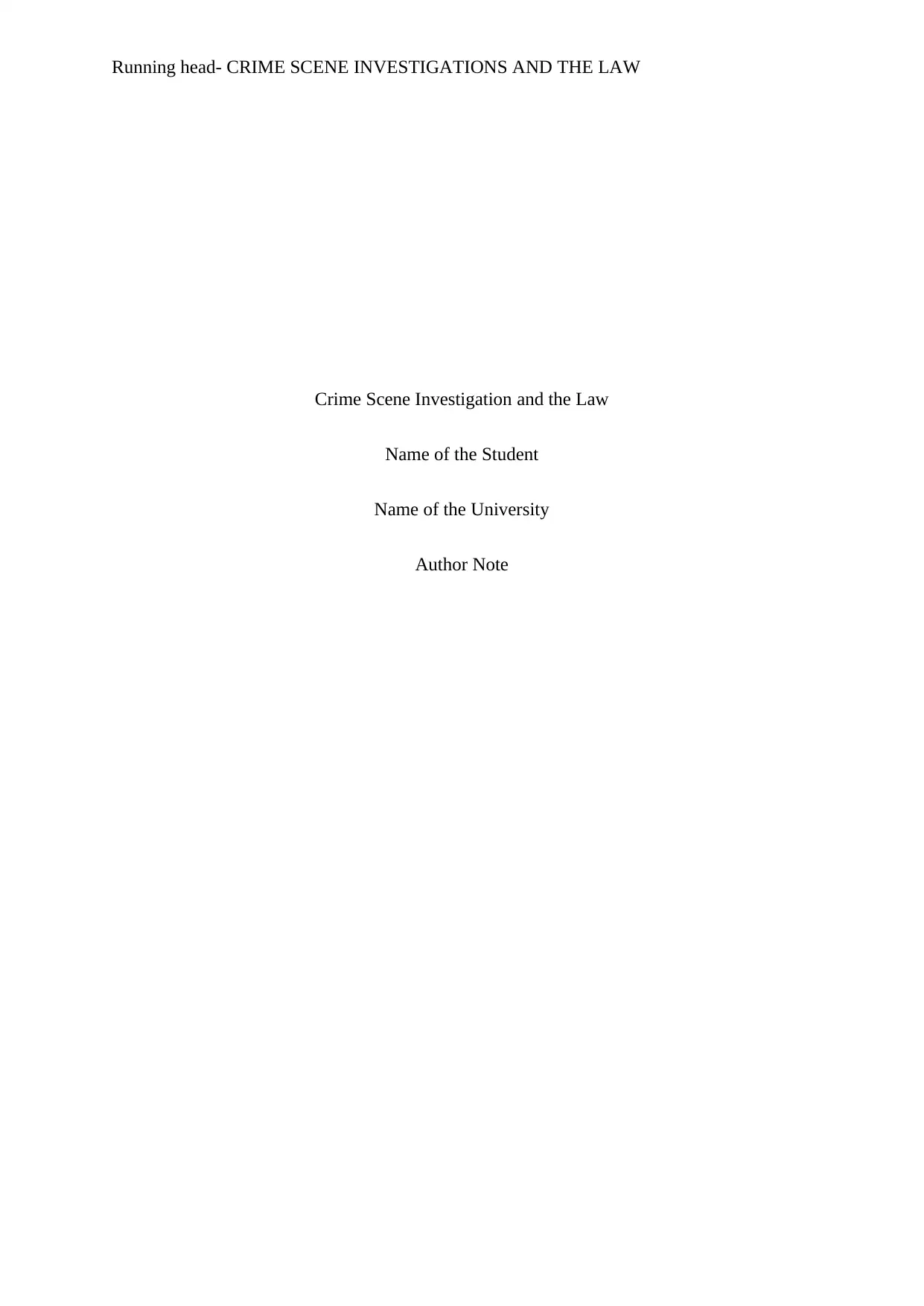
Running head- CRIME SCENE INVESTIGATIONS AND THE LAW
Crime Scene Investigation and the Law
Name of the Student
Name of the University
Author Note
Crime Scene Investigation and the Law
Name of the Student
Name of the University
Author Note
Paraphrase This Document
Need a fresh take? Get an instant paraphrase of this document with our AI Paraphraser
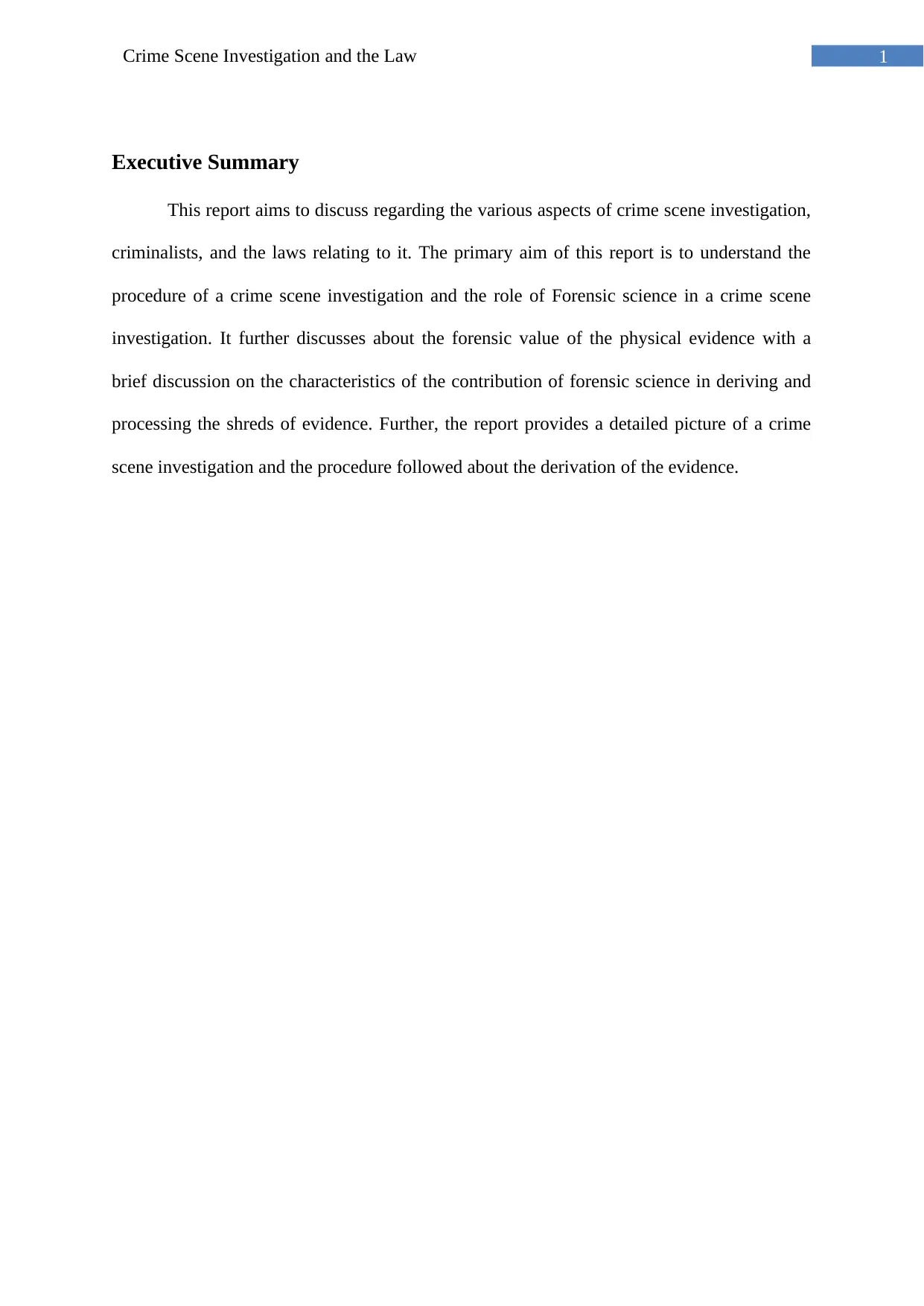
1Crime Scene Investigation and the Law
Executive Summary
This report aims to discuss regarding the various aspects of crime scene investigation,
criminalists, and the laws relating to it. The primary aim of this report is to understand the
procedure of a crime scene investigation and the role of Forensic science in a crime scene
investigation. It further discusses about the forensic value of the physical evidence with a
brief discussion on the characteristics of the contribution of forensic science in deriving and
processing the shreds of evidence. Further, the report provides a detailed picture of a crime
scene investigation and the procedure followed about the derivation of the evidence.
Executive Summary
This report aims to discuss regarding the various aspects of crime scene investigation,
criminalists, and the laws relating to it. The primary aim of this report is to understand the
procedure of a crime scene investigation and the role of Forensic science in a crime scene
investigation. It further discusses about the forensic value of the physical evidence with a
brief discussion on the characteristics of the contribution of forensic science in deriving and
processing the shreds of evidence. Further, the report provides a detailed picture of a crime
scene investigation and the procedure followed about the derivation of the evidence.
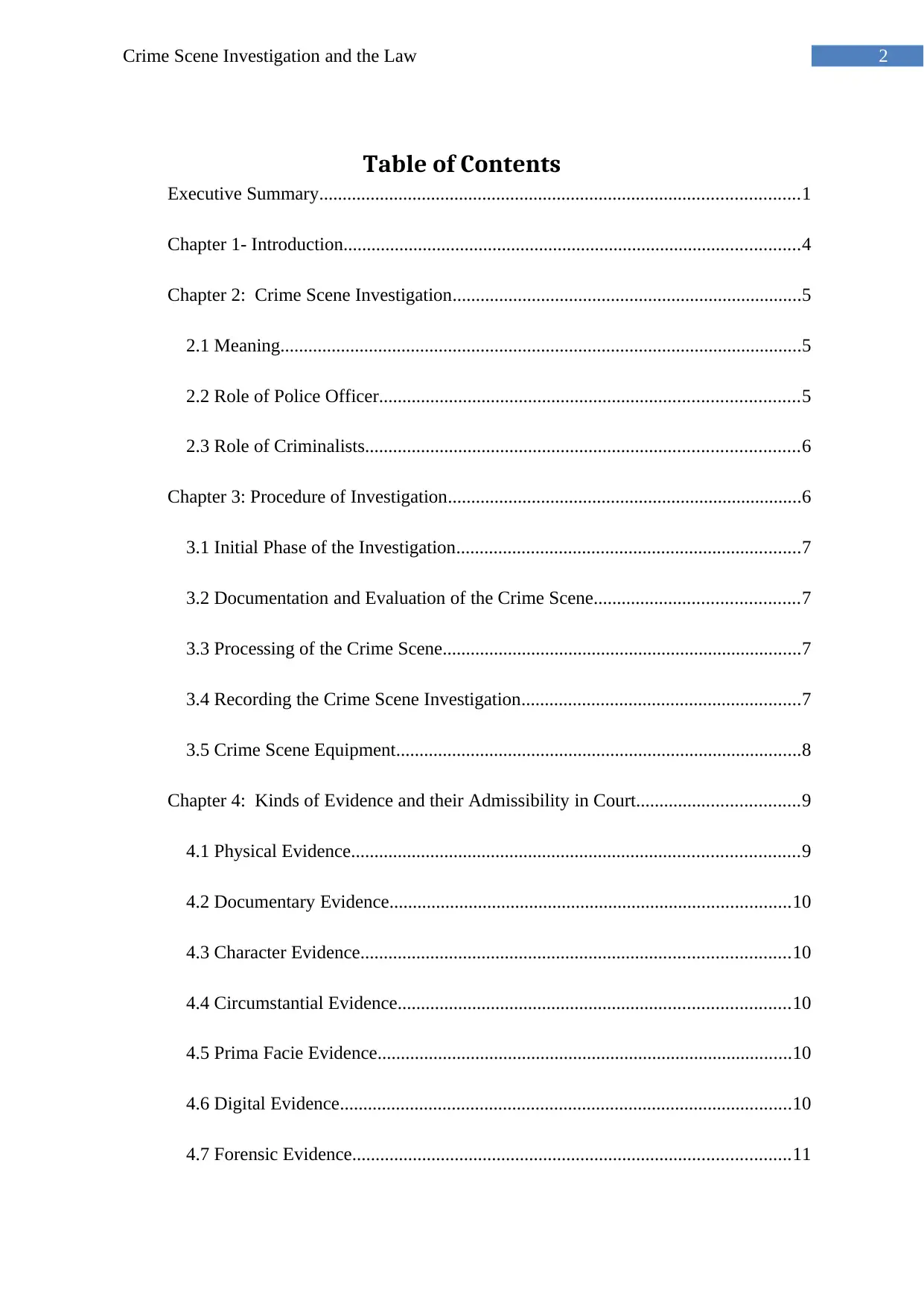
2Crime Scene Investigation and the Law
Table of Contents
Executive Summary.......................................................................................................1
Chapter 1- Introduction..................................................................................................4
Chapter 2: Crime Scene Investigation...........................................................................5
2.1 Meaning................................................................................................................5
2.2 Role of Police Officer..........................................................................................5
2.3 Role of Criminalists.............................................................................................6
Chapter 3: Procedure of Investigation............................................................................6
3.1 Initial Phase of the Investigation..........................................................................7
3.2 Documentation and Evaluation of the Crime Scene............................................7
3.3 Processing of the Crime Scene.............................................................................7
3.4 Recording the Crime Scene Investigation............................................................7
3.5 Crime Scene Equipment.......................................................................................8
Chapter 4: Kinds of Evidence and their Admissibility in Court...................................9
4.1 Physical Evidence................................................................................................9
4.2 Documentary Evidence......................................................................................10
4.3 Character Evidence............................................................................................10
4.4 Circumstantial Evidence....................................................................................10
4.5 Prima Facie Evidence.........................................................................................10
4.6 Digital Evidence.................................................................................................10
4.7 Forensic Evidence..............................................................................................11
Table of Contents
Executive Summary.......................................................................................................1
Chapter 1- Introduction..................................................................................................4
Chapter 2: Crime Scene Investigation...........................................................................5
2.1 Meaning................................................................................................................5
2.2 Role of Police Officer..........................................................................................5
2.3 Role of Criminalists.............................................................................................6
Chapter 3: Procedure of Investigation............................................................................6
3.1 Initial Phase of the Investigation..........................................................................7
3.2 Documentation and Evaluation of the Crime Scene............................................7
3.3 Processing of the Crime Scene.............................................................................7
3.4 Recording the Crime Scene Investigation............................................................7
3.5 Crime Scene Equipment.......................................................................................8
Chapter 4: Kinds of Evidence and their Admissibility in Court...................................9
4.1 Physical Evidence................................................................................................9
4.2 Documentary Evidence......................................................................................10
4.3 Character Evidence............................................................................................10
4.4 Circumstantial Evidence....................................................................................10
4.5 Prima Facie Evidence.........................................................................................10
4.6 Digital Evidence.................................................................................................10
4.7 Forensic Evidence..............................................................................................11
⊘ This is a preview!⊘
Do you want full access?
Subscribe today to unlock all pages.

Trusted by 1+ million students worldwide
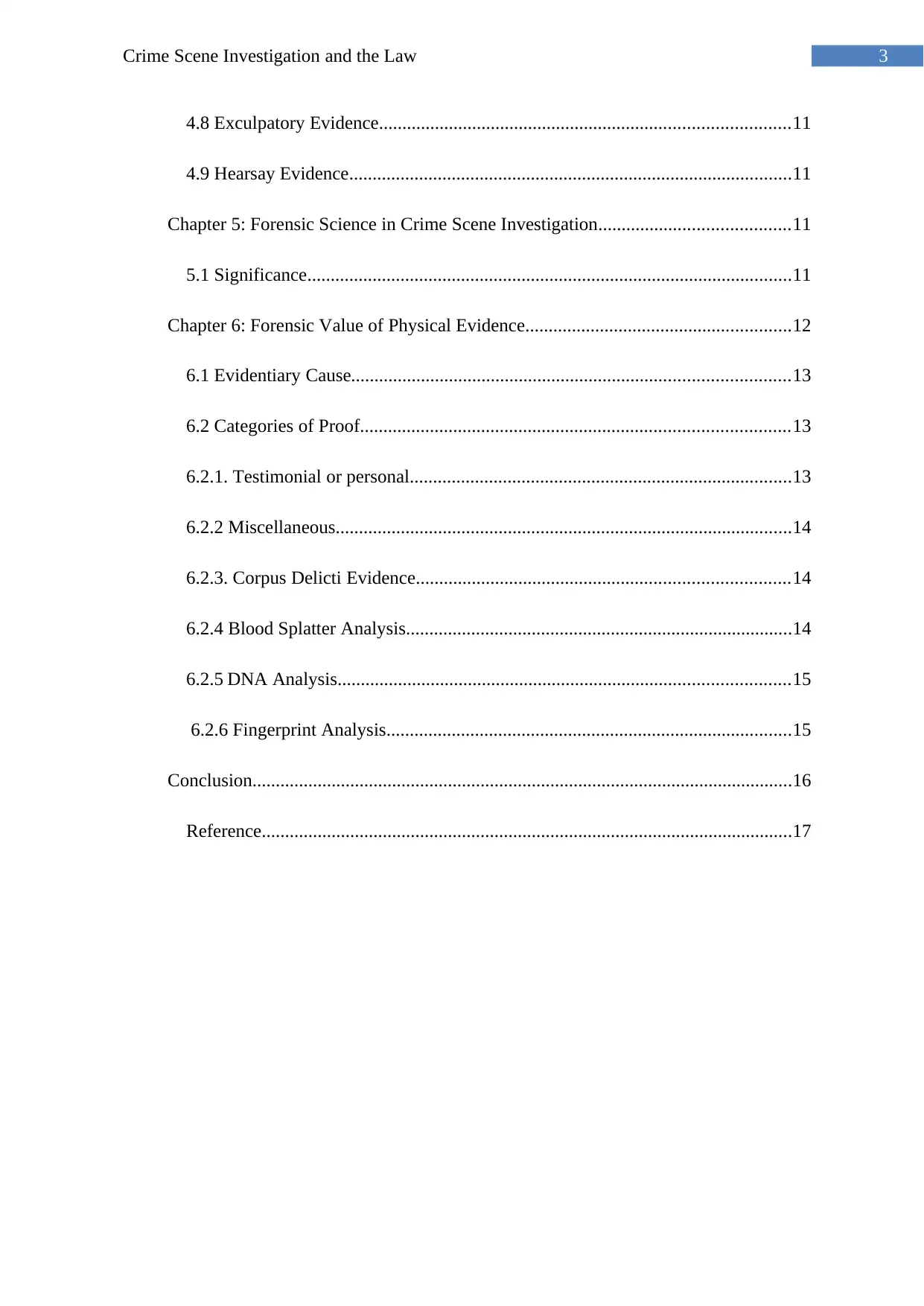
3Crime Scene Investigation and the Law
4.8 Exculpatory Evidence........................................................................................11
4.9 Hearsay Evidence...............................................................................................11
Chapter 5: Forensic Science in Crime Scene Investigation.........................................11
5.1 Significance........................................................................................................11
Chapter 6: Forensic Value of Physical Evidence.........................................................12
6.1 Evidentiary Cause..............................................................................................13
6.2 Categories of Proof............................................................................................13
6.2.1. Testimonial or personal..................................................................................13
6.2.2 Miscellaneous..................................................................................................14
6.2.3. Corpus Delicti Evidence................................................................................14
6.2.4 Blood Splatter Analysis...................................................................................14
6.2.5 DNA Analysis.................................................................................................15
6.2.6 Fingerprint Analysis.......................................................................................15
Conclusion....................................................................................................................16
Reference..................................................................................................................17
4.8 Exculpatory Evidence........................................................................................11
4.9 Hearsay Evidence...............................................................................................11
Chapter 5: Forensic Science in Crime Scene Investigation.........................................11
5.1 Significance........................................................................................................11
Chapter 6: Forensic Value of Physical Evidence.........................................................12
6.1 Evidentiary Cause..............................................................................................13
6.2 Categories of Proof............................................................................................13
6.2.1. Testimonial or personal..................................................................................13
6.2.2 Miscellaneous..................................................................................................14
6.2.3. Corpus Delicti Evidence................................................................................14
6.2.4 Blood Splatter Analysis...................................................................................14
6.2.5 DNA Analysis.................................................................................................15
6.2.6 Fingerprint Analysis.......................................................................................15
Conclusion....................................................................................................................16
Reference..................................................................................................................17
Paraphrase This Document
Need a fresh take? Get an instant paraphrase of this document with our AI Paraphraser
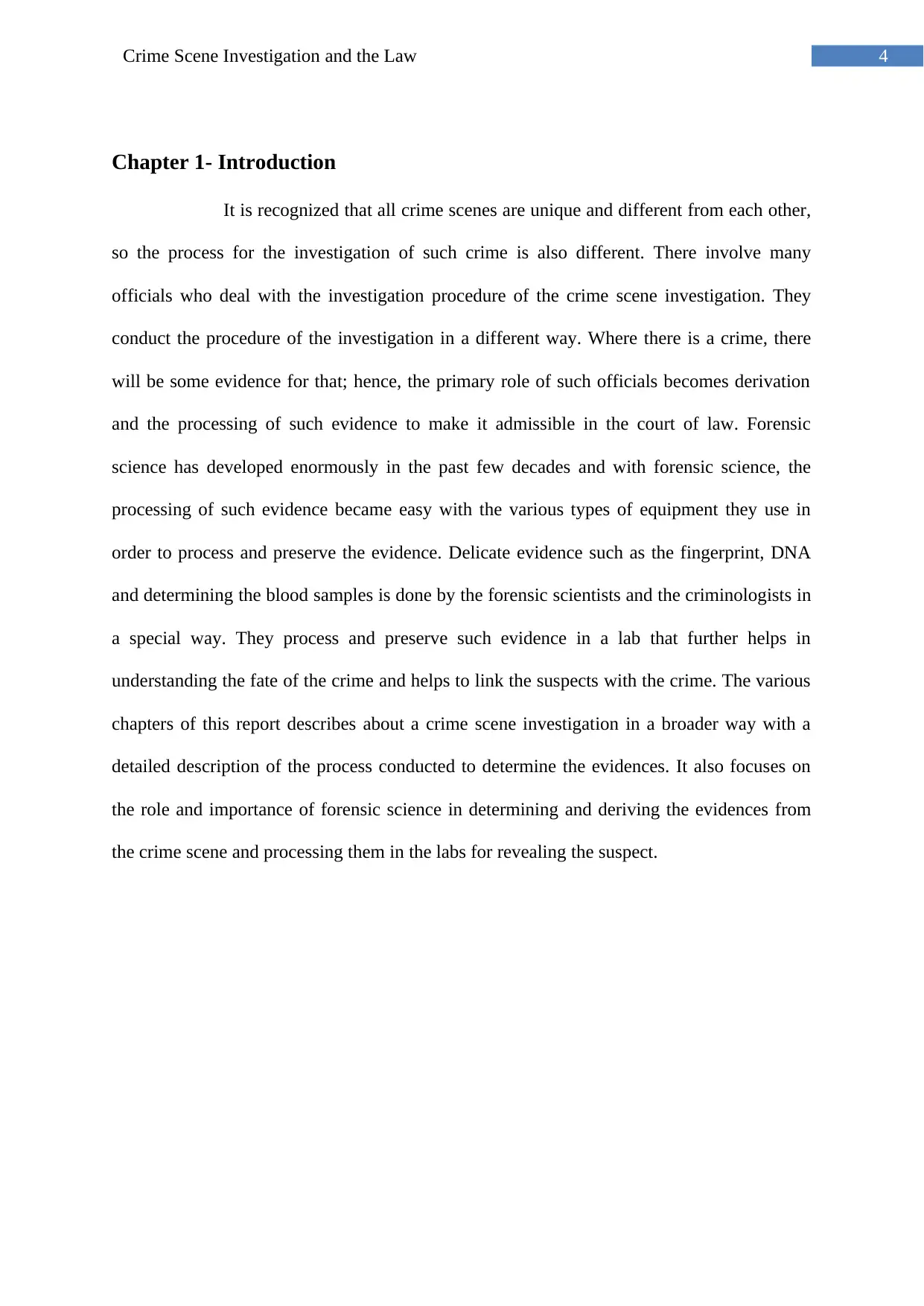
4Crime Scene Investigation and the Law
Chapter 1- Introduction
It is recognized that all crime scenes are unique and different from each other,
so the process for the investigation of such crime is also different. There involve many
officials who deal with the investigation procedure of the crime scene investigation. They
conduct the procedure of the investigation in a different way. Where there is a crime, there
will be some evidence for that; hence, the primary role of such officials becomes derivation
and the processing of such evidence to make it admissible in the court of law. Forensic
science has developed enormously in the past few decades and with forensic science, the
processing of such evidence became easy with the various types of equipment they use in
order to process and preserve the evidence. Delicate evidence such as the fingerprint, DNA
and determining the blood samples is done by the forensic scientists and the criminologists in
a special way. They process and preserve such evidence in a lab that further helps in
understanding the fate of the crime and helps to link the suspects with the crime. The various
chapters of this report describes about a crime scene investigation in a broader way with a
detailed description of the process conducted to determine the evidences. It also focuses on
the role and importance of forensic science in determining and deriving the evidences from
the crime scene and processing them in the labs for revealing the suspect.
Chapter 1- Introduction
It is recognized that all crime scenes are unique and different from each other,
so the process for the investigation of such crime is also different. There involve many
officials who deal with the investigation procedure of the crime scene investigation. They
conduct the procedure of the investigation in a different way. Where there is a crime, there
will be some evidence for that; hence, the primary role of such officials becomes derivation
and the processing of such evidence to make it admissible in the court of law. Forensic
science has developed enormously in the past few decades and with forensic science, the
processing of such evidence became easy with the various types of equipment they use in
order to process and preserve the evidence. Delicate evidence such as the fingerprint, DNA
and determining the blood samples is done by the forensic scientists and the criminologists in
a special way. They process and preserve such evidence in a lab that further helps in
understanding the fate of the crime and helps to link the suspects with the crime. The various
chapters of this report describes about a crime scene investigation in a broader way with a
detailed description of the process conducted to determine the evidences. It also focuses on
the role and importance of forensic science in determining and deriving the evidences from
the crime scene and processing them in the labs for revealing the suspect.
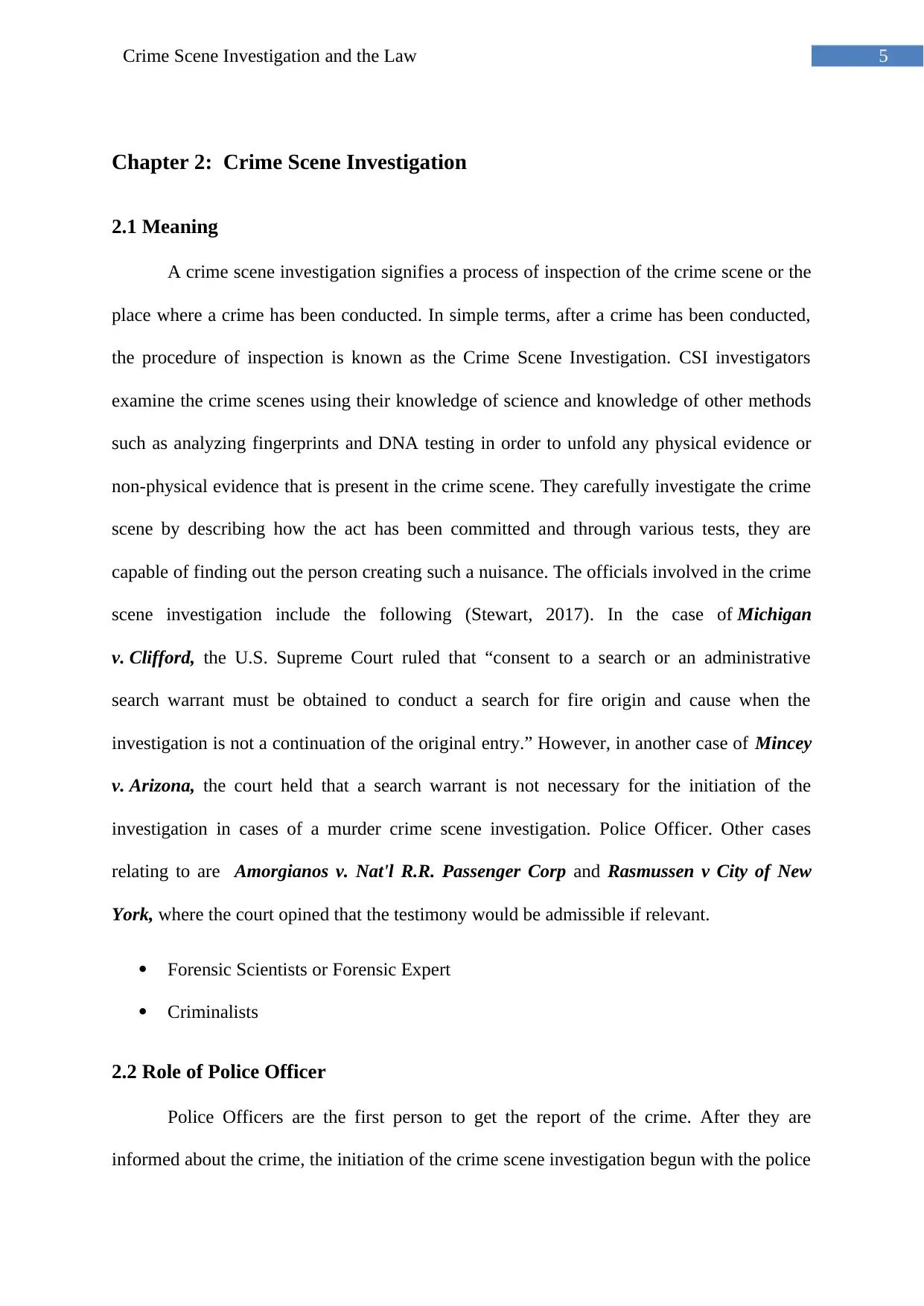
5Crime Scene Investigation and the Law
Chapter 2: Crime Scene Investigation
2.1 Meaning
A crime scene investigation signifies a process of inspection of the crime scene or the
place where a crime has been conducted. In simple terms, after a crime has been conducted,
the procedure of inspection is known as the Crime Scene Investigation. CSI investigators
examine the crime scenes using their knowledge of science and knowledge of other methods
such as analyzing fingerprints and DNA testing in order to unfold any physical evidence or
non-physical evidence that is present in the crime scene. They carefully investigate the crime
scene by describing how the act has been committed and through various tests, they are
capable of finding out the person creating such a nuisance. The officials involved in the crime
scene investigation include the following (Stewart, 2017). In the case of Michigan
v. Clifford, the U.S. Supreme Court ruled that “consent to a search or an administrative
search warrant must be obtained to conduct a search for fire origin and cause when the
investigation is not a continuation of the original entry.” However, in another case of Mincey
v. Arizona, the court held that a search warrant is not necessary for the initiation of the
investigation in cases of a murder crime scene investigation. Police Officer. Other cases
relating to are Amorgianos v. Nat'l R.R. Passenger Corp and Rasmussen v City of New
York, where the court opined that the testimony would be admissible if relevant.
Forensic Scientists or Forensic Expert
Criminalists
2.2 Role of Police Officer
Police Officers are the first person to get the report of the crime. After they are
informed about the crime, the initiation of the crime scene investigation begun with the police
Chapter 2: Crime Scene Investigation
2.1 Meaning
A crime scene investigation signifies a process of inspection of the crime scene or the
place where a crime has been conducted. In simple terms, after a crime has been conducted,
the procedure of inspection is known as the Crime Scene Investigation. CSI investigators
examine the crime scenes using their knowledge of science and knowledge of other methods
such as analyzing fingerprints and DNA testing in order to unfold any physical evidence or
non-physical evidence that is present in the crime scene. They carefully investigate the crime
scene by describing how the act has been committed and through various tests, they are
capable of finding out the person creating such a nuisance. The officials involved in the crime
scene investigation include the following (Stewart, 2017). In the case of Michigan
v. Clifford, the U.S. Supreme Court ruled that “consent to a search or an administrative
search warrant must be obtained to conduct a search for fire origin and cause when the
investigation is not a continuation of the original entry.” However, in another case of Mincey
v. Arizona, the court held that a search warrant is not necessary for the initiation of the
investigation in cases of a murder crime scene investigation. Police Officer. Other cases
relating to are Amorgianos v. Nat'l R.R. Passenger Corp and Rasmussen v City of New
York, where the court opined that the testimony would be admissible if relevant.
Forensic Scientists or Forensic Expert
Criminalists
2.2 Role of Police Officer
Police Officers are the first person to get the report of the crime. After they are
informed about the crime, the initiation of the crime scene investigation begun with the police
⊘ This is a preview!⊘
Do you want full access?
Subscribe today to unlock all pages.

Trusted by 1+ million students worldwide
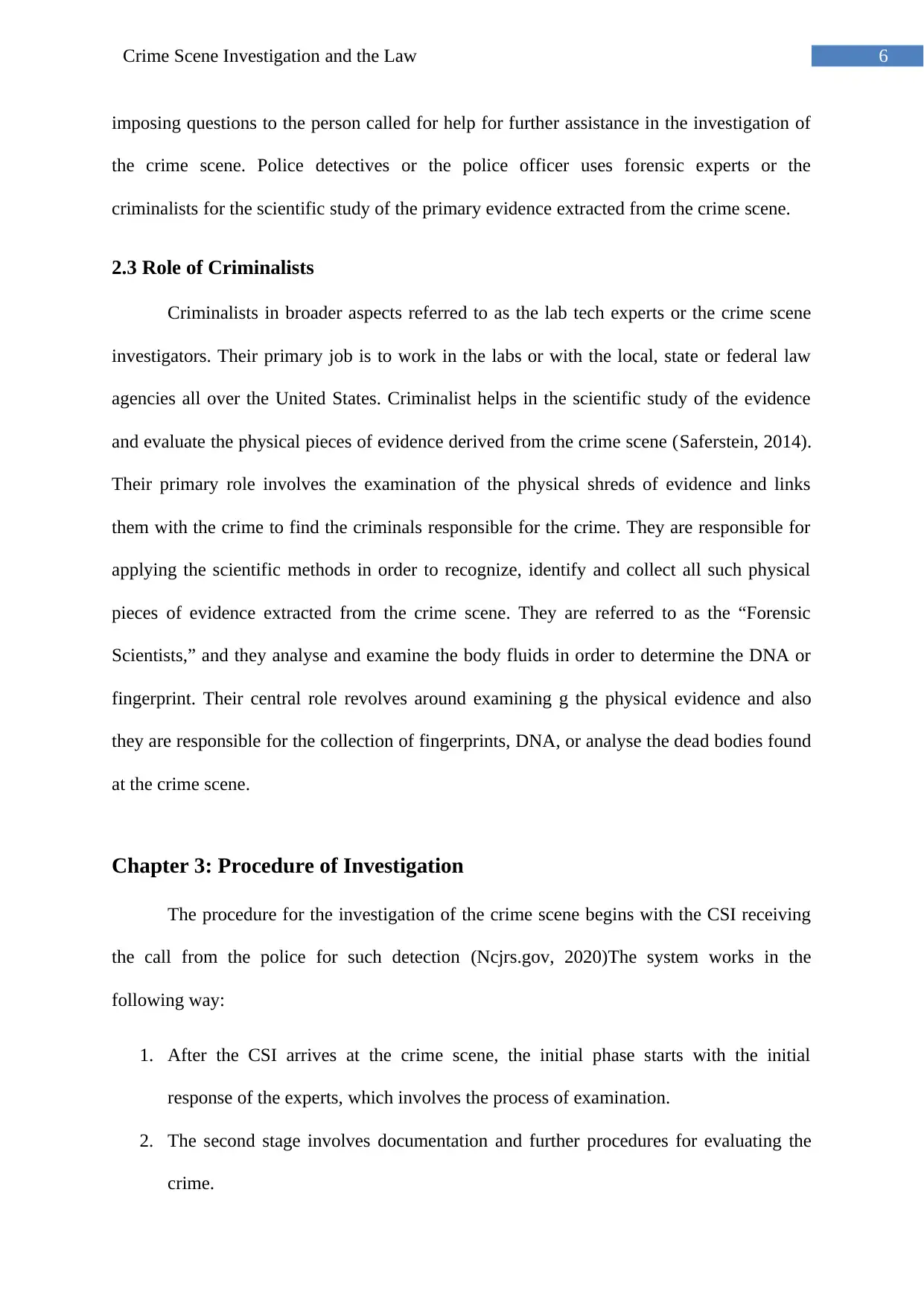
6Crime Scene Investigation and the Law
imposing questions to the person called for help for further assistance in the investigation of
the crime scene. Police detectives or the police officer uses forensic experts or the
criminalists for the scientific study of the primary evidence extracted from the crime scene.
2.3 Role of Criminalists
Criminalists in broader aspects referred to as the lab tech experts or the crime scene
investigators. Their primary job is to work in the labs or with the local, state or federal law
agencies all over the United States. Criminalist helps in the scientific study of the evidence
and evaluate the physical pieces of evidence derived from the crime scene (Saferstein, 2014).
Their primary role involves the examination of the physical shreds of evidence and links
them with the crime to find the criminals responsible for the crime. They are responsible for
applying the scientific methods in order to recognize, identify and collect all such physical
pieces of evidence extracted from the crime scene. They are referred to as the “Forensic
Scientists,” and they analyse and examine the body fluids in order to determine the DNA or
fingerprint. Their central role revolves around examining g the physical evidence and also
they are responsible for the collection of fingerprints, DNA, or analyse the dead bodies found
at the crime scene.
Chapter 3: Procedure of Investigation
The procedure for the investigation of the crime scene begins with the CSI receiving
the call from the police for such detection (Ncjrs.gov, 2020)The system works in the
following way:
1. After the CSI arrives at the crime scene, the initial phase starts with the initial
response of the experts, which involves the process of examination.
2. The second stage involves documentation and further procedures for evaluating the
crime.
imposing questions to the person called for help for further assistance in the investigation of
the crime scene. Police detectives or the police officer uses forensic experts or the
criminalists for the scientific study of the primary evidence extracted from the crime scene.
2.3 Role of Criminalists
Criminalists in broader aspects referred to as the lab tech experts or the crime scene
investigators. Their primary job is to work in the labs or with the local, state or federal law
agencies all over the United States. Criminalist helps in the scientific study of the evidence
and evaluate the physical pieces of evidence derived from the crime scene (Saferstein, 2014).
Their primary role involves the examination of the physical shreds of evidence and links
them with the crime to find the criminals responsible for the crime. They are responsible for
applying the scientific methods in order to recognize, identify and collect all such physical
pieces of evidence extracted from the crime scene. They are referred to as the “Forensic
Scientists,” and they analyse and examine the body fluids in order to determine the DNA or
fingerprint. Their central role revolves around examining g the physical evidence and also
they are responsible for the collection of fingerprints, DNA, or analyse the dead bodies found
at the crime scene.
Chapter 3: Procedure of Investigation
The procedure for the investigation of the crime scene begins with the CSI receiving
the call from the police for such detection (Ncjrs.gov, 2020)The system works in the
following way:
1. After the CSI arrives at the crime scene, the initial phase starts with the initial
response of the experts, which involves the process of examination.
2. The second stage involves documentation and further procedures for evaluating the
crime.
Paraphrase This Document
Need a fresh take? Get an instant paraphrase of this document with our AI Paraphraser
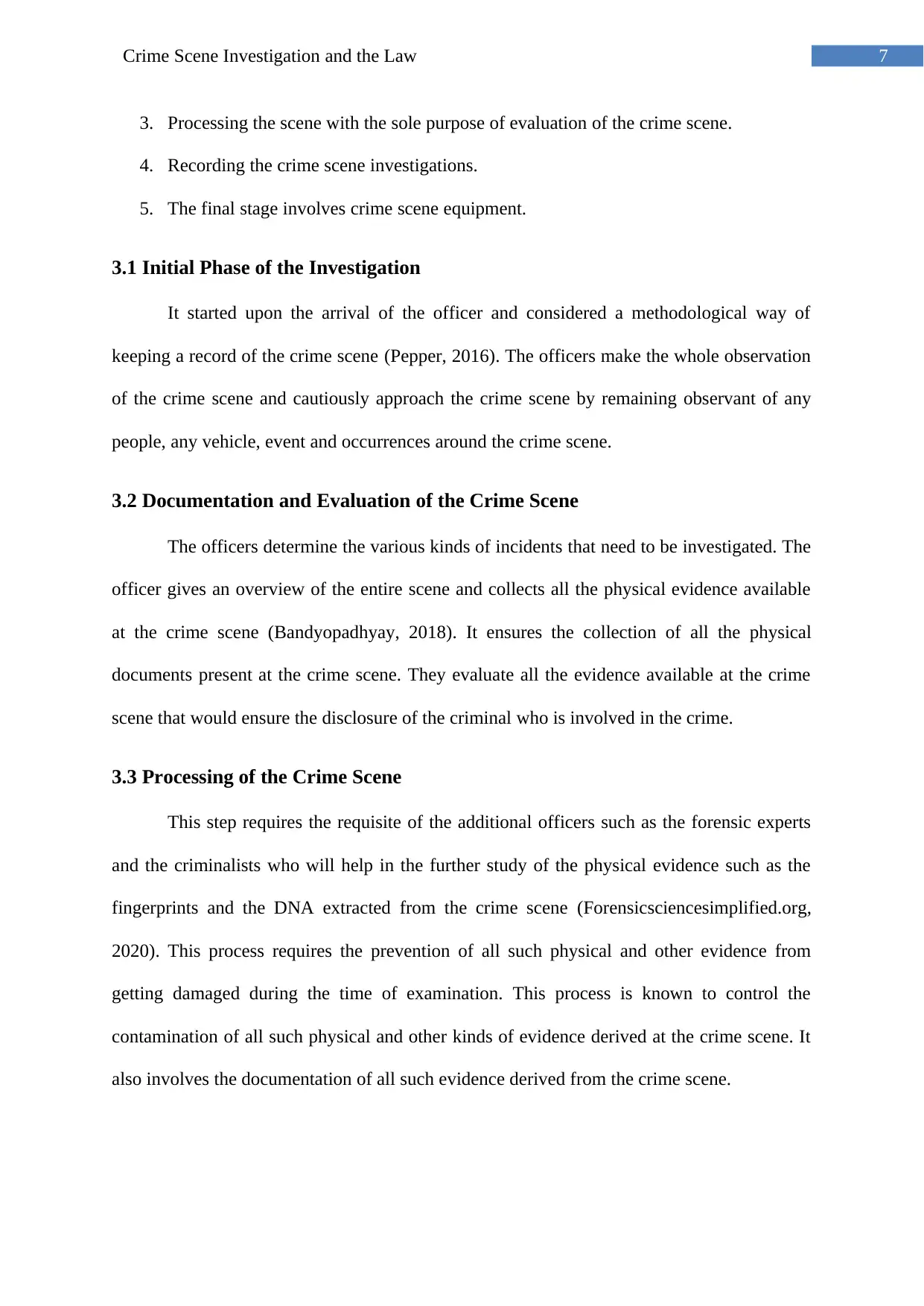
7Crime Scene Investigation and the Law
3. Processing the scene with the sole purpose of evaluation of the crime scene.
4. Recording the crime scene investigations.
5. The final stage involves crime scene equipment.
3.1 Initial Phase of the Investigation
It started upon the arrival of the officer and considered a methodological way of
keeping a record of the crime scene (Pepper, 2016). The officers make the whole observation
of the crime scene and cautiously approach the crime scene by remaining observant of any
people, any vehicle, event and occurrences around the crime scene.
3.2 Documentation and Evaluation of the Crime Scene
The officers determine the various kinds of incidents that need to be investigated. The
officer gives an overview of the entire scene and collects all the physical evidence available
at the crime scene (Bandyopadhyay, 2018). It ensures the collection of all the physical
documents present at the crime scene. They evaluate all the evidence available at the crime
scene that would ensure the disclosure of the criminal who is involved in the crime.
3.3 Processing of the Crime Scene
This step requires the requisite of the additional officers such as the forensic experts
and the criminalists who will help in the further study of the physical evidence such as the
fingerprints and the DNA extracted from the crime scene (Forensicsciencesimplified.org,
2020). This process requires the prevention of all such physical and other evidence from
getting damaged during the time of examination. This process is known to control the
contamination of all such physical and other kinds of evidence derived at the crime scene. It
also involves the documentation of all such evidence derived from the crime scene.
3. Processing the scene with the sole purpose of evaluation of the crime scene.
4. Recording the crime scene investigations.
5. The final stage involves crime scene equipment.
3.1 Initial Phase of the Investigation
It started upon the arrival of the officer and considered a methodological way of
keeping a record of the crime scene (Pepper, 2016). The officers make the whole observation
of the crime scene and cautiously approach the crime scene by remaining observant of any
people, any vehicle, event and occurrences around the crime scene.
3.2 Documentation and Evaluation of the Crime Scene
The officers determine the various kinds of incidents that need to be investigated. The
officer gives an overview of the entire scene and collects all the physical evidence available
at the crime scene (Bandyopadhyay, 2018). It ensures the collection of all the physical
documents present at the crime scene. They evaluate all the evidence available at the crime
scene that would ensure the disclosure of the criminal who is involved in the crime.
3.3 Processing of the Crime Scene
This step requires the requisite of the additional officers such as the forensic experts
and the criminalists who will help in the further study of the physical evidence such as the
fingerprints and the DNA extracted from the crime scene (Forensicsciencesimplified.org,
2020). This process requires the prevention of all such physical and other evidence from
getting damaged during the time of examination. This process is known to control the
contamination of all such physical and other kinds of evidence derived at the crime scene. It
also involves the documentation of all such evidence derived from the crime scene.
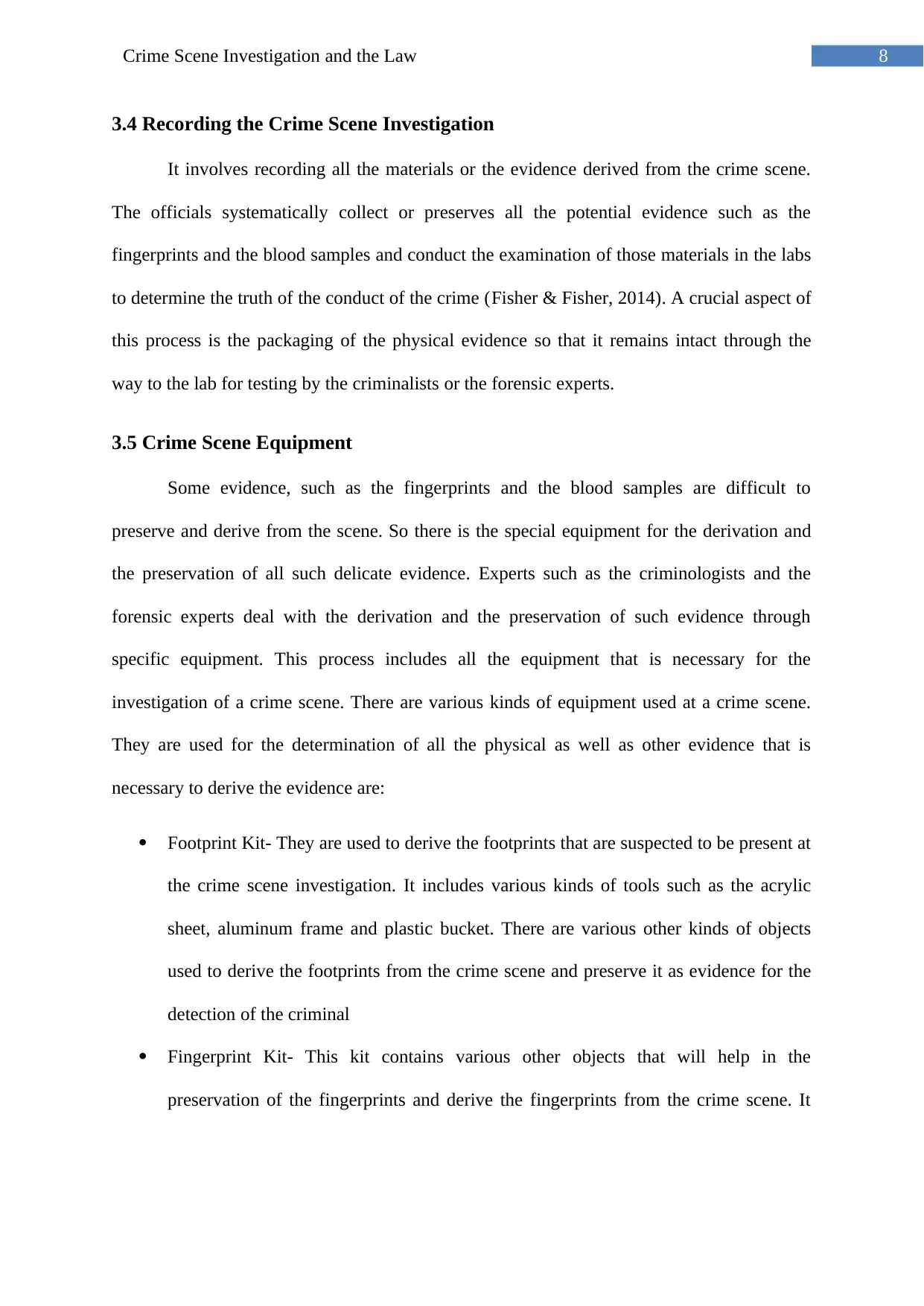
8Crime Scene Investigation and the Law
3.4 Recording the Crime Scene Investigation
It involves recording all the materials or the evidence derived from the crime scene.
The officials systematically collect or preserves all the potential evidence such as the
fingerprints and the blood samples and conduct the examination of those materials in the labs
to determine the truth of the conduct of the crime (Fisher & Fisher, 2014). A crucial aspect of
this process is the packaging of the physical evidence so that it remains intact through the
way to the lab for testing by the criminalists or the forensic experts.
3.5 Crime Scene Equipment
Some evidence, such as the fingerprints and the blood samples are difficult to
preserve and derive from the scene. So there is the special equipment for the derivation and
the preservation of all such delicate evidence. Experts such as the criminologists and the
forensic experts deal with the derivation and the preservation of such evidence through
specific equipment. This process includes all the equipment that is necessary for the
investigation of a crime scene. There are various kinds of equipment used at a crime scene.
They are used for the determination of all the physical as well as other evidence that is
necessary to derive the evidence are:
Footprint Kit- They are used to derive the footprints that are suspected to be present at
the crime scene investigation. It includes various kinds of tools such as the acrylic
sheet, aluminum frame and plastic bucket. There are various other kinds of objects
used to derive the footprints from the crime scene and preserve it as evidence for the
detection of the criminal
Fingerprint Kit- This kit contains various other objects that will help in the
preservation of the fingerprints and derive the fingerprints from the crime scene. It
3.4 Recording the Crime Scene Investigation
It involves recording all the materials or the evidence derived from the crime scene.
The officials systematically collect or preserves all the potential evidence such as the
fingerprints and the blood samples and conduct the examination of those materials in the labs
to determine the truth of the conduct of the crime (Fisher & Fisher, 2014). A crucial aspect of
this process is the packaging of the physical evidence so that it remains intact through the
way to the lab for testing by the criminalists or the forensic experts.
3.5 Crime Scene Equipment
Some evidence, such as the fingerprints and the blood samples are difficult to
preserve and derive from the scene. So there is the special equipment for the derivation and
the preservation of all such delicate evidence. Experts such as the criminologists and the
forensic experts deal with the derivation and the preservation of such evidence through
specific equipment. This process includes all the equipment that is necessary for the
investigation of a crime scene. There are various kinds of equipment used at a crime scene.
They are used for the determination of all the physical as well as other evidence that is
necessary to derive the evidence are:
Footprint Kit- They are used to derive the footprints that are suspected to be present at
the crime scene investigation. It includes various kinds of tools such as the acrylic
sheet, aluminum frame and plastic bucket. There are various other kinds of objects
used to derive the footprints from the crime scene and preserve it as evidence for the
detection of the criminal
Fingerprint Kit- This kit contains various other objects that will help in the
preservation of the fingerprints and derive the fingerprints from the crime scene. It
⊘ This is a preview!⊘
Do you want full access?
Subscribe today to unlock all pages.

Trusted by 1+ million students worldwide
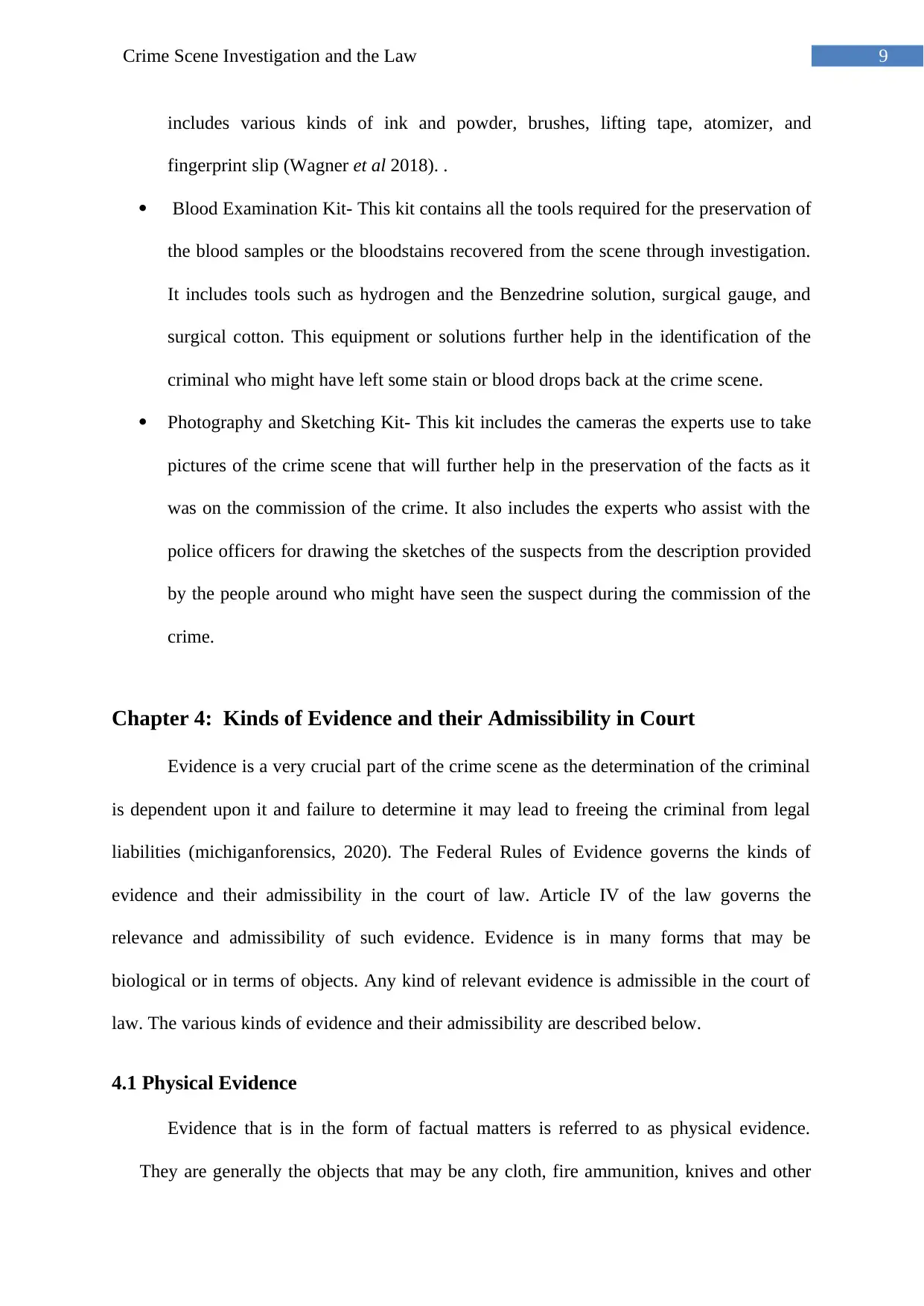
9Crime Scene Investigation and the Law
includes various kinds of ink and powder, brushes, lifting tape, atomizer, and
fingerprint slip (Wagner et al 2018). .
Blood Examination Kit- This kit contains all the tools required for the preservation of
the blood samples or the bloodstains recovered from the scene through investigation.
It includes tools such as hydrogen and the Benzedrine solution, surgical gauge, and
surgical cotton. This equipment or solutions further help in the identification of the
criminal who might have left some stain or blood drops back at the crime scene.
Photography and Sketching Kit- This kit includes the cameras the experts use to take
pictures of the crime scene that will further help in the preservation of the facts as it
was on the commission of the crime. It also includes the experts who assist with the
police officers for drawing the sketches of the suspects from the description provided
by the people around who might have seen the suspect during the commission of the
crime.
Chapter 4: Kinds of Evidence and their Admissibility in Court
Evidence is a very crucial part of the crime scene as the determination of the criminal
is dependent upon it and failure to determine it may lead to freeing the criminal from legal
liabilities (michiganforensics, 2020). The Federal Rules of Evidence governs the kinds of
evidence and their admissibility in the court of law. Article IV of the law governs the
relevance and admissibility of such evidence. Evidence is in many forms that may be
biological or in terms of objects. Any kind of relevant evidence is admissible in the court of
law. The various kinds of evidence and their admissibility are described below.
4.1 Physical Evidence
Evidence that is in the form of factual matters is referred to as physical evidence.
They are generally the objects that may be any cloth, fire ammunition, knives and other
includes various kinds of ink and powder, brushes, lifting tape, atomizer, and
fingerprint slip (Wagner et al 2018). .
Blood Examination Kit- This kit contains all the tools required for the preservation of
the blood samples or the bloodstains recovered from the scene through investigation.
It includes tools such as hydrogen and the Benzedrine solution, surgical gauge, and
surgical cotton. This equipment or solutions further help in the identification of the
criminal who might have left some stain or blood drops back at the crime scene.
Photography and Sketching Kit- This kit includes the cameras the experts use to take
pictures of the crime scene that will further help in the preservation of the facts as it
was on the commission of the crime. It also includes the experts who assist with the
police officers for drawing the sketches of the suspects from the description provided
by the people around who might have seen the suspect during the commission of the
crime.
Chapter 4: Kinds of Evidence and their Admissibility in Court
Evidence is a very crucial part of the crime scene as the determination of the criminal
is dependent upon it and failure to determine it may lead to freeing the criminal from legal
liabilities (michiganforensics, 2020). The Federal Rules of Evidence governs the kinds of
evidence and their admissibility in the court of law. Article IV of the law governs the
relevance and admissibility of such evidence. Evidence is in many forms that may be
biological or in terms of objects. Any kind of relevant evidence is admissible in the court of
law. The various kinds of evidence and their admissibility are described below.
4.1 Physical Evidence
Evidence that is in the form of factual matters is referred to as physical evidence.
They are generally the objects that may be any cloth, fire ammunition, knives and other
Paraphrase This Document
Need a fresh take? Get an instant paraphrase of this document with our AI Paraphraser
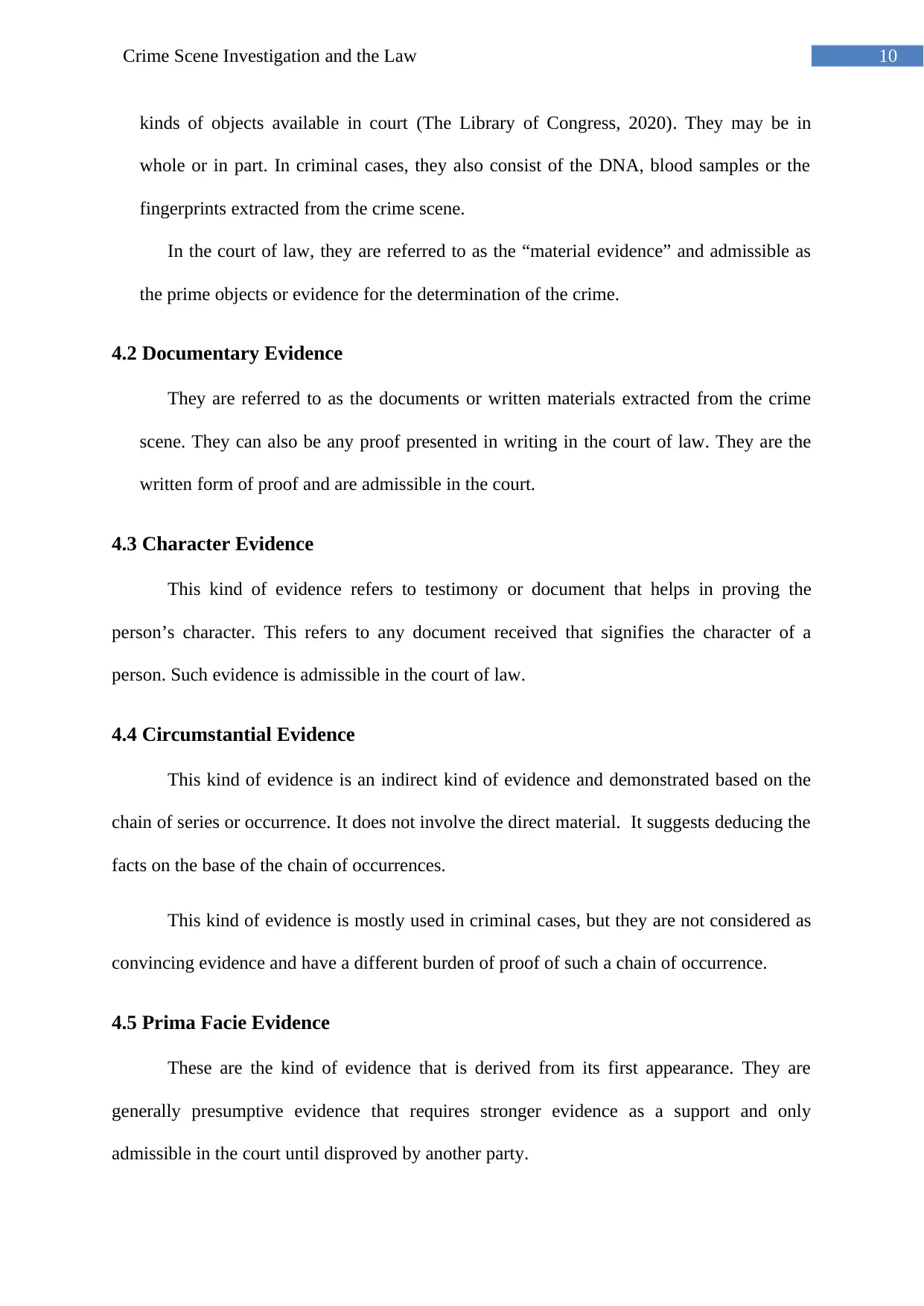
10Crime Scene Investigation and the Law
kinds of objects available in court (The Library of Congress, 2020). They may be in
whole or in part. In criminal cases, they also consist of the DNA, blood samples or the
fingerprints extracted from the crime scene.
In the court of law, they are referred to as the “material evidence” and admissible as
the prime objects or evidence for the determination of the crime.
4.2 Documentary Evidence
They are referred to as the documents or written materials extracted from the crime
scene. They can also be any proof presented in writing in the court of law. They are the
written form of proof and are admissible in the court.
4.3 Character Evidence
This kind of evidence refers to testimony or document that helps in proving the
person’s character. This refers to any document received that signifies the character of a
person. Such evidence is admissible in the court of law.
4.4 Circumstantial Evidence
This kind of evidence is an indirect kind of evidence and demonstrated based on the
chain of series or occurrence. It does not involve the direct material. It suggests deducing the
facts on the base of the chain of occurrences.
This kind of evidence is mostly used in criminal cases, but they are not considered as
convincing evidence and have a different burden of proof of such a chain of occurrence.
4.5 Prima Facie Evidence
These are the kind of evidence that is derived from its first appearance. They are
generally presumptive evidence that requires stronger evidence as a support and only
admissible in the court until disproved by another party.
kinds of objects available in court (The Library of Congress, 2020). They may be in
whole or in part. In criminal cases, they also consist of the DNA, blood samples or the
fingerprints extracted from the crime scene.
In the court of law, they are referred to as the “material evidence” and admissible as
the prime objects or evidence for the determination of the crime.
4.2 Documentary Evidence
They are referred to as the documents or written materials extracted from the crime
scene. They can also be any proof presented in writing in the court of law. They are the
written form of proof and are admissible in the court.
4.3 Character Evidence
This kind of evidence refers to testimony or document that helps in proving the
person’s character. This refers to any document received that signifies the character of a
person. Such evidence is admissible in the court of law.
4.4 Circumstantial Evidence
This kind of evidence is an indirect kind of evidence and demonstrated based on the
chain of series or occurrence. It does not involve the direct material. It suggests deducing the
facts on the base of the chain of occurrences.
This kind of evidence is mostly used in criminal cases, but they are not considered as
convincing evidence and have a different burden of proof of such a chain of occurrence.
4.5 Prima Facie Evidence
These are the kind of evidence that is derived from its first appearance. They are
generally presumptive evidence that requires stronger evidence as a support and only
admissible in the court until disproved by another party.
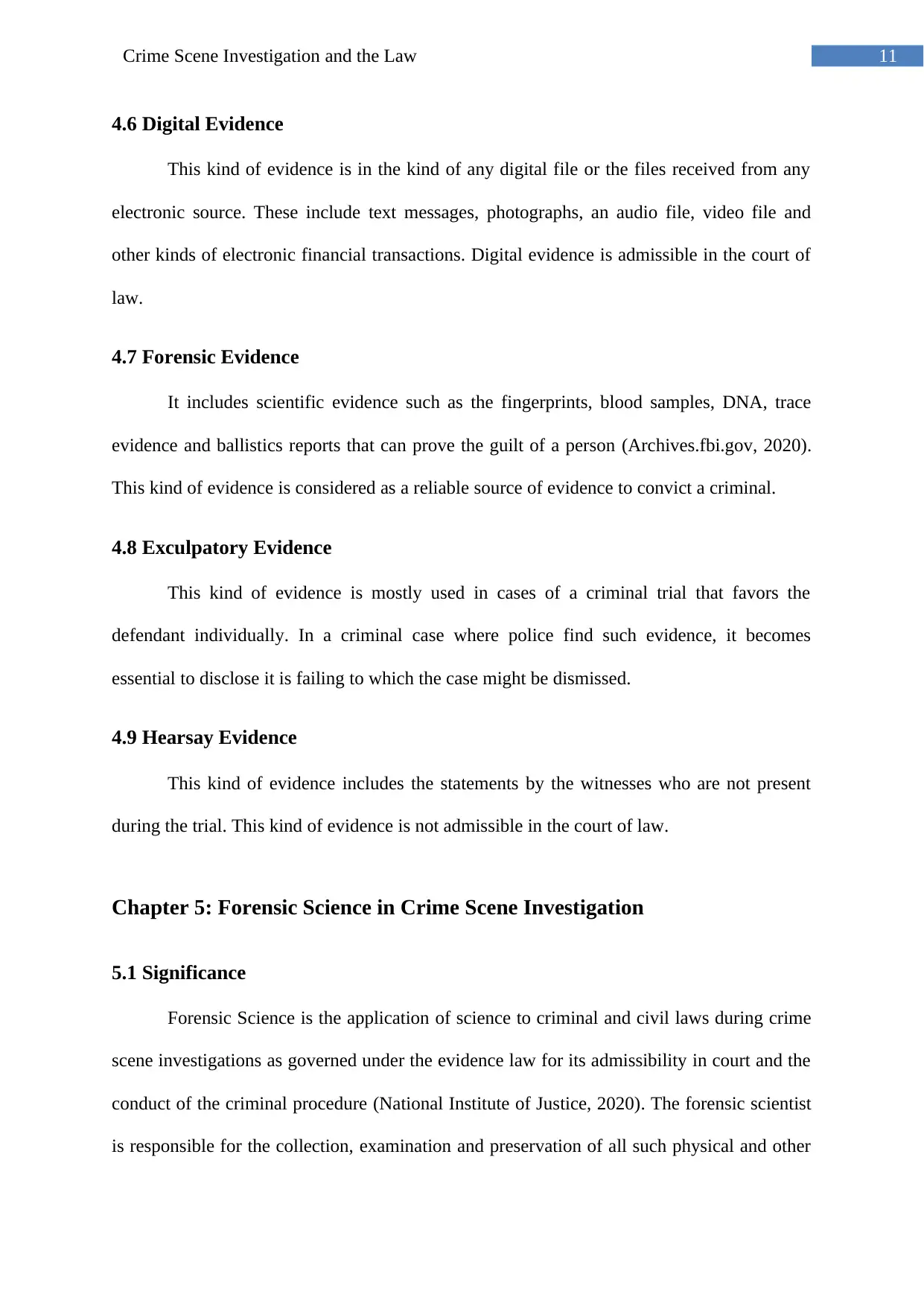
11Crime Scene Investigation and the Law
4.6 Digital Evidence
This kind of evidence is in the kind of any digital file or the files received from any
electronic source. These include text messages, photographs, an audio file, video file and
other kinds of electronic financial transactions. Digital evidence is admissible in the court of
law.
4.7 Forensic Evidence
It includes scientific evidence such as the fingerprints, blood samples, DNA, trace
evidence and ballistics reports that can prove the guilt of a person (Archives.fbi.gov, 2020).
This kind of evidence is considered as a reliable source of evidence to convict a criminal.
4.8 Exculpatory Evidence
This kind of evidence is mostly used in cases of a criminal trial that favors the
defendant individually. In a criminal case where police find such evidence, it becomes
essential to disclose it is failing to which the case might be dismissed.
4.9 Hearsay Evidence
This kind of evidence includes the statements by the witnesses who are not present
during the trial. This kind of evidence is not admissible in the court of law.
Chapter 5: Forensic Science in Crime Scene Investigation
5.1 Significance
Forensic Science is the application of science to criminal and civil laws during crime
scene investigations as governed under the evidence law for its admissibility in court and the
conduct of the criminal procedure (National Institute of Justice, 2020). The forensic scientist
is responsible for the collection, examination and preservation of all such physical and other
4.6 Digital Evidence
This kind of evidence is in the kind of any digital file or the files received from any
electronic source. These include text messages, photographs, an audio file, video file and
other kinds of electronic financial transactions. Digital evidence is admissible in the court of
law.
4.7 Forensic Evidence
It includes scientific evidence such as the fingerprints, blood samples, DNA, trace
evidence and ballistics reports that can prove the guilt of a person (Archives.fbi.gov, 2020).
This kind of evidence is considered as a reliable source of evidence to convict a criminal.
4.8 Exculpatory Evidence
This kind of evidence is mostly used in cases of a criminal trial that favors the
defendant individually. In a criminal case where police find such evidence, it becomes
essential to disclose it is failing to which the case might be dismissed.
4.9 Hearsay Evidence
This kind of evidence includes the statements by the witnesses who are not present
during the trial. This kind of evidence is not admissible in the court of law.
Chapter 5: Forensic Science in Crime Scene Investigation
5.1 Significance
Forensic Science is the application of science to criminal and civil laws during crime
scene investigations as governed under the evidence law for its admissibility in court and the
conduct of the criminal procedure (National Institute of Justice, 2020). The forensic scientist
is responsible for the collection, examination and preservation of all such physical and other
⊘ This is a preview!⊘
Do you want full access?
Subscribe today to unlock all pages.

Trusted by 1+ million students worldwide
1 out of 20
Related Documents
Your All-in-One AI-Powered Toolkit for Academic Success.
+13062052269
info@desklib.com
Available 24*7 on WhatsApp / Email
![[object Object]](/_next/static/media/star-bottom.7253800d.svg)
Unlock your academic potential
Copyright © 2020–2025 A2Z Services. All Rights Reserved. Developed and managed by ZUCOL.




